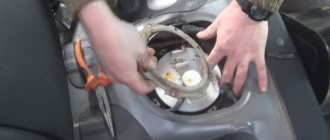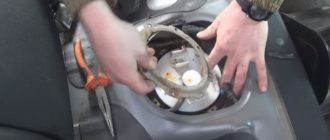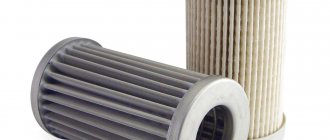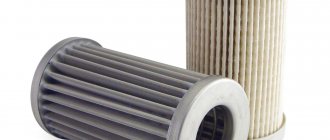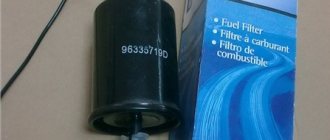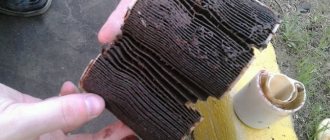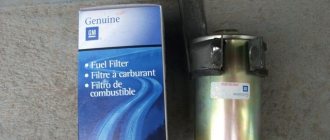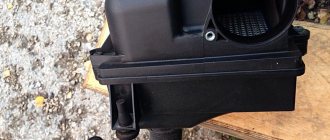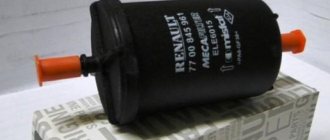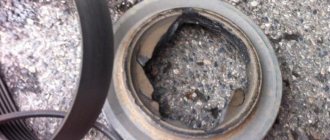The cleanliness and timeliness of oxygen entering the fuel equipment is extremely important to ensure the performance of the vehicle and the power unit as a whole. The completeness of combustion of the fuel mixture determines throttle response, acceleration dynamics, and power indicators. Lack of air leads to depletion of the combustible mixture, engine detonation, and reduced power.
Kia Rio cars are equipped with two fuel filters: coarse filter (mesh filter - a mesh bag) and fine filter (plastic block with a filter element inside). Both filters are components of the fuel module located in the fuel tank.
Technical regulations for replacement
In order to maintain the functionality of the technical product, the manufacturer recommends replacing the Kia Rio fuel filter every 30,000 km. mileage In this case, maintenance is carried out every 15,000 km. In practice, this interval is not maintained. Car enthusiasts who care about their vehicles update cleaning elements every 10,000 km.
The replacement process is not at all complicated; every car owner can do it. Specialists are rarely called to the workshop in case of detection of a large-scale breakdown or other malfunction that requires prompt intervention by a professional.
Useful tips for motorists
In most cases, practice shows that the manufacturer does not define clear periods for replacing this filter. Therefore, all responsibility falls on the shoulders of the driver; in order to maintain not only the fuel system, but also other components and assemblies of the car in working condition, it is necessary to pay attention to the operation of the engine, especially at high speeds. Increased fuel consumption, jerking and jolting when driving at low speed are the first signs of the need to possibly replace the fuel filter.
The frequency of replacing the filter element in most cases depends on the quality of the fuel used. The content of suspended matter, resins and metal particles in the fuel will significantly reduce the service life of the filter. It is worth remembering that the fuel filter on diesel cars needs to be changed much earlier than on gasoline cars.
Reduced fuel pressure Kia Rio
In operating condition, the fuel pressure in the system is significantly higher than atmospheric pressure. To prevent uncontrolled spills of gasoline, all work related to depressurization of the system is carried out with the pressure released. To relieve pressure, first turn off the fuel pump by removing the fuel module power connector or removing the fuse. Then the engine is started and the remaining fuel is exhausted. Without additional actions, the pressure drops on its own 2–3 hours after the ignition is turned off.
To work, you will need a flathead and Phillips screwdriver. The procedure for releasing pressure is as follows.
- Remove (if necessary, pry up with a screwdriver) the plastic cover of the fuse box located to the left of the steering column.
- In operating condition, the fuel pressure in the system is significantly higher than atmospheric pressure. To prevent uncontrolled spills of gasoline, all work related to depressurization of the system is carried out with the pressure released. To relieve pressure, first turn off the fuel pump by removing the fuel module power connector or removing the fuse. Then the engine is started and the remaining fuel is exhausted. Without additional actions, the pressure drops on its own 2–3 hours after the ignition is turned off.
- To work, you will need a flathead and Phillips screwdriver. The procedure for releasing pressure is as follows.
- Remove (if necessary, pry up with a screwdriver) the plastic cover of the fuse box located to the left of the steering column.
- To remove the fuel module (instead of removing the fuse), lift the rear seat and trim flaps underneath, unscrew the mounting screws, remove the hatch cover and disconnect the module's power connector.
- Start the engine and wait for it to stop spontaneously.
- Use the starter to turn the crankshaft several times.
What is the point of regular replacement?
It is necessary to observe the frequency of changing the fuel filter. This will reduce the load on the engine and reduce the likelihood of carbon deposits forming inside the power plant. The car will behave more confidently when accelerating. Regularly changing the unit will also save on fuel.
You can increase the resource of the cleaning system using 3 tips:
- You need to refuel only at proven gas stations operating under the brands of large companies.
- Do not store fuel in old rusty cans.
- You should not go to a gas station immediately after filling it with fuel from a tanker.
Don't forget about the need to change the filter. This is fraught with damage. Moreover, the car can “stop” right on the highway, far from civilization.
How to replace the fuel filter on a Kia Rio - step-by-step instructions
In order to replace the fuel filter on Kia Rio cars, you must perform the following steps:
- The fuel module is located in the fuel tank located under the rear passenger seat.
- Lift the seat cushion and remove the fastening brackets from the holders.
- Remove the rear seat cushion completely. Under the seat there is an access hatch to the fuel module. To open it, use a knife, because... it is glued with sealant (although self-tapping screws would be quite suitable for fixing it).
- Disconnect the fuel module power supply (ignition must be turned off).
- Using pliers, remove the fuel vapor supply hose to the adsorber. Remove the fuel supply pipe.
- Remove the tube holder from the mount on the fuel module cover. Using a socket wrench 8, unscrew the bolts securing the fuel module cover plate.
- Open the rear doors of the car to ventilate fuel vapors. Remove the fuel module from the fuel tank (be careful not to damage the float).
- Now, to get to the fine and coarse filters, you have to disassemble the fuel module. First remove the fuel level sensor. To do this, disconnect the sensor connector from the module cover.
- Remove the wires from the holders. Use a screwdriver to pry the sensor retainer and slide it down.
- Next, disconnect the fuel pump power plug. Disconnect the tube that supplies fuel to the fine filter. To do this, use a screwdriver to pull out the lock.
- Separate the cover and the fuel module glass. Now you should remove the fine filter with the fuel pump built into it from the glass.
- To remove the fuel pump from the filter housing, press the clamps. Disconnect the fuel coarse filter from the fuel pump.
- When disassembling the fine filter, disconnect the O-ring and the remaining wire. Disconnect the pressure regulator and the remaining fuel drain pipe.
- The fuel filter has been removed. That's it, now you should assemble the fuel module with new filters in reverse order.
Car enthusiasts recommend carrying out preventive maintenance followed by replacement every 10,000 km. In this case, you can count on the longevity of the technical device. Premature replacement of the cleaning element is also justified in the case of systematic filling of the tank by 40 - 60%. The likelihood of sediment formation increases several times.
Which one to buy and when to change it
The installation of a new filter element on the Kia Rio 4 is carried out during the fourth scheduled maintenance, when the car approaches the 60 thousand km mark.
Updating the consumables involves dismantling the fuel module. The manufacturer recommends using an original spare part sold under catalog number 31112-F9000 . Together with it, the tank ventilation filter is changed - 31453H5000.
An inspection and subsequent replacement of a clogged device is carried out when the output of the power plant decreases, starting is difficult, or a problem is suspected in the emission control system.
The Kia Rio 4 maintenance schedule with consumables articles is described in detail in this material.
If you don't change, what will happen?
If you do not change the component in time, you will heavily load the pump, which will find it difficult to push fuel through the system, because the fuel pump screen is already clogged. The car will begin to pick up speed worse, its power will decrease, and the original dynamics will disappear. Sometimes you will observe power dips when the internal combustion engine is running. This is especially noticeable when driving uphill.
The engine will start worse day by day - until the moment when it fails altogether. And this happens sometimes.
Due to problems with the filter, fuel consumption will increase. For example, if previously a car consumed 9-10 liters per 100 km, then with a clogged filter this figure can increase to 11-12 liters. Dips will appear when you press the accelerator pedal. This can lead to an accident when overtaking on a country highway when you need to accelerate sharply.
At that moment, when you are standing at a traffic light, the engine speed in idle mode can fluctuate - right up to the point where the internal combustion engine stalls. You will remain standing at the crossroads - there is little pleasure in this.
The process of replacing a part on the Rio model is presented in this video:
List of works with a mileage of 210,000 km
Perform all work of the second scheduled maintenance . And:
The first coolant replacement should be performed after 210,000 km or 120 months, then every 120,000 km or every 5 years (but better once every 3 years).
Replacing engine cooling system fluid. The coolant is a mixture of antifreeze and water (ethylene glycol with phosphate-based coolant for aluminum radiators). The catalog number of the concentrate in a four-liter canister “Hyundai long life coolant” (green) is 07100-00400, the price is 3,400 rubles. 2 liter bottle is 1600 rubles. Product code 07100-00200.
Filter selection
When repairing or replacing a filter device, you need to choose the right part for installation.
When purchasing, you should be guided by the catalog numbers of fuel purifiers:
- the fine cleaning device has article number 31112-1G000;
- fuel coarse cleaning element - No. 31090-1G000;
- rubber sealing ring for pumping device - 31118-3J300;
- sealing rubber directly for the filter - 31115-1 G000.
If you do not have the opportunity to buy original spare parts for Kia, you can opt for analogues.
List of works during maintenance 2 (for 30,000 km)
The maintenance schedule every 30 thousand km includes all work provided for by Maintenance 1 plus additional procedures:
Replacing brake fluid and clutch fluid ( for cars with manual transmission ). Any DOT 4 brake fluid will do. The system volume is less than one liter. The price of one liter of brake and clutch fluid DOT 4 Hyundai/Kia “BRAKE FLUID” is 2100 rubles. Product code 01100-00130.
Brake fluid is very hygroscopic and absorbs moisture from the air. Therefore, it must be regularly checked for its percentage of water and completely replaced if the maximum concentration threshold is exceeded.
Checks during maintenance 2 and all subsequent ones through one maintenance :
- Condition of the fuel tank ventilation air filter.
- Drive belts.
- Engine crankcase ventilation system hoses.
- Wheel drive shafts, wheel bearings, CV joints .
- Disc brakes, discs and pads.
- Fuel filter.
- Fuel tank ventilation air filter (if equipped).
